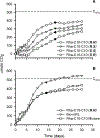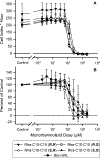Biodegradability and toxicity of monorhamnolipid biosurfactant diastereomers
- PMID: 30390580
- PMCID: PMC6289288
- DOI: 10.1016/j.jhazmat.2018.10.050
Biodegradability and toxicity of monorhamnolipid biosurfactant diastereomers
Abstract
Synthetic monorhamnolipids differ from biologically produced material because they are produced as single congeners, depending on the β-hydroxyalkanoic acid used during synthesis. Each congener is produced as one of four possible diastereomers resulting from two chiral centers at the carbinols of the lipid tails [(R,R), (R,S), (S,R) and (S,S)]. We compare the biodegradability (CO2 respirometry), acute toxicity (Microtox assay), embryo toxicity (Zebrafish assay), and cytotoxicity (xCELLigence and MTS assays) of synthetic rhamnosyl-β-hydroxydecanoyl-β-hydroxydecanoate (Rha-C10-C10) monorhamnolipids against biosynthesized monorhamnolipid mixtures (bio-mRL). All Rha-C10-C10 diastereomers and bio-mRL were inherently biodegradable ranging from 34 to 92% mineralized. The Microtox assay showed all Rha-C10-C10 diastereomers and bio-mRL are slightly toxic according to the US EPA ecotoxicity categories with 5 min EC50 values ranging from 39.6 to 87.5 μM. The zebrafish assay showed that of 22 developmental endpoints tested, only mortality was observed at 120 h post fertilization; all Rha-C10-C10 diastereomers and bio-mRL caused significant mortality at 640 μM, except the Rha-C10-C10 (R,R) which showed no developmental effects. xCELLigence and MTS showed IC50 values ranging from 103.4 to 191.1 μM for human lung cell line H1299 after 72 h exposure. These data provide key information regarding Rha-C10-C10 diastereomers that is pertinent when considering potential applications.
Keywords: Biodegradation; Biosurfactant; Rhamnolipid; Stereochemistry; Toxicity.
Copyright © 2018 Elsevier B.V. All rights reserved.
Figures




References
-
- Shah A, Shahzad S, Munir A, Nadagouda MN, Khan GS, Shams DF, Dionysiou DD, Rana UA, Micelles as soil and water decontamination agents, Chem. Rev 116 (2016) 6042–6074. - PubMed
-
- Rebello S, Asok AK, Mundayoor S, Jisha M, Surfactants: toxicity, remediation and green surfactants, Environ. Chem. Lett 12 (2014) 275–287.
Publication types
MeSH terms
Substances
Grants and funding
LinkOut - more resources
Full Text Sources
Research Materials

